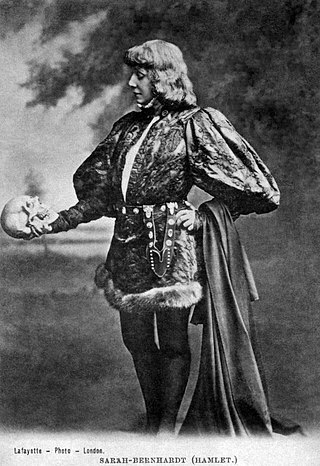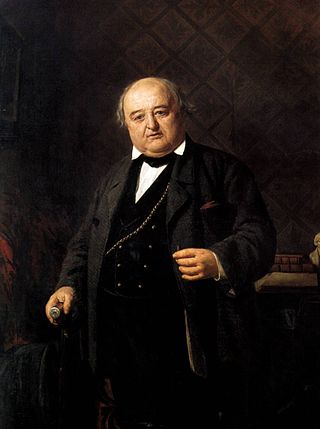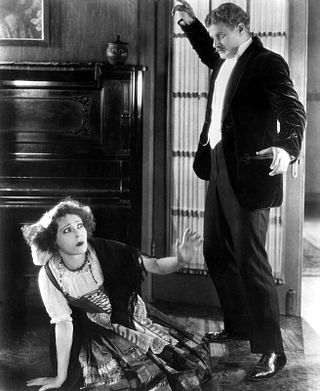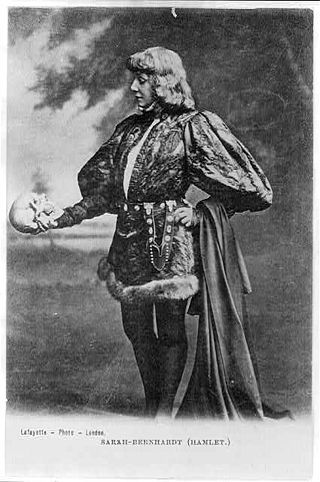Related Research Articles

Acting is an activity in which a story is told by means of its enactment by an actor who adopts a character—in theatre, television, film, radio, or any other medium that makes use of the mimetic mode.

Konstantin Sergeyevich Stanislavski was a seminal Soviet Russian theatre practitioner. He was widely recognized as an outstanding character actor, and the many productions that he directed garnered him a reputation as one of the leading theatre directors of his generation. His principal fame and influence, however, rests on his "system" of actor training, preparation, and rehearsal technique.

Method acting, known as The Method, is a range of rehearsal techniques, as formulated by a number of different theatre practitioners, that seeks to encourage sincere and expressive performances through identifying with, understanding, and experiencing a character's inner motivation and emotions. These techniques are built on Stanislavski's system, developed by the Russian actor and director Konstantin Stanislavski and captured in his books An Actor Prepares, Building a Character, and Creating a Role.

The Seagull is a play by Russian dramatist Anton Chekhov, written in 1895 and first produced in 1896. The Seagull is generally considered to be the first of his four major plays. It dramatizes the romantic and artistic conflicts between four characters: the famous middlebrow story writer Boris Trigorin, the ingenue Nina, the fading actress Irina Arkadina, and her son the symbolist playwright Konstantin Treplev.

Stanislavski's system is a systematic approach to training actors that the Russian theatre practitioner Konstantin Stanislavski developed in the first half of the twentieth century. His system cultivates what he calls the "art of experiencing". It mobilises the actor's conscious thought and will in order to activate other, less-controllable psychological processes—such as emotional experience and subconscious behaviour—sympathetically and indirectly. In rehearsal, the actor searches for inner motives to justify action and the definition of what the character seeks to achieve at any given moment.

In acting, units of action, otherwise known as bits or beats, are sections that a play's action can be divided into for the purposes of dramatic exploration in rehearsal.

Tommaso Salvini was an Italian actor.

Mikhail Semyonovich Shchepkin was the most famous Russian Empire actor of the 19th century. He is considered the "father" of realist acting in Russia and, via the influence of his student, Glikeriya Fedotova, a major influence on the development of the 'system' of Konstantin Stanislavski. Shchepkin's significance to the Theatre of Russia is comparable to that of David Garrick to the English theatre.

The Moscow Art Theatre (or MAT; Russian: Московский Художественный академический театр, Moskovskiy Hudojestvenny Akademicheskiy Teatr was a theatre company in Moscow. It was founded in 1898 by the seminal Russian theatre practitioner Konstantin Stanislavski, together with the playwright and director Vladimir Nemirovich-Danchenko. It was conceived as a venue for naturalistic theatre, in contrast to the melodramas that were Russia's dominant form of theatre at the time. The theatre, the first to regularly put on shows implementing Stanislavski's system, proved hugely influential in the acting world and in the development of modern American theatre and drama.
Psychotechnique forms part of the 'system' of actor training, preparation, and rehearsal developed by the Russian theatre practitioner Konstantin Stanislavski. It describes the inner, psychological elements of training that support what he called "experiencing" a role in performance. In a rehearsal process, psychotechnique is interrelated with the "embodiment" of the role, in order to achieve a fully realised characterisation. Stanislavski describes the elements of psychotechnique in the first part of his manual An Actor's Work.
Twentieth-century theatre describes a period of great change within the theatrical culture of the 20th century, mainly in Europe and North America. There was a widespread challenge to long-established rules surrounding theatrical representation; resulting in the development of many new forms of theatre, including modernism, expressionism, impressionism, political theatre and other forms of Experimental theatre, as well as the continuing development of already established theatrical forms like naturalism and realism.
My Life in Art is the autobiography of the Russian actor and theatre director Konstantin Stanislavski. It was first commissioned while Stanislavski was in the United States on tour with the Moscow Art Theatre, and was first published in Boston, Massachusetts in English in 1924. It was later revised and published in a Russian-language edition in Moscow under the title Моя жизнь в искусстве. It is divided into 4 sections entitled: 1-Artistic Childhood, 2-Artistic Youth, 3-Artistic Adolescence and 4-Artistic Adulthood.

Realism in the theatre was a general movement that began in 19th-century theatre, around the 1870s, and remained present through much of the 20th century. It developed a set of dramatic and theatrical conventions with the aim of bringing a greater fidelity of real life to texts and performances. These conventions occur in the text, design, performance style, and narrative structure. They include recreating on stage a facsimile of real life except missing a fourth wall. Characters speak in naturalistic, authentic dialogue without verse or poetic stylings, and acting is meant to emulate human behaviour in real life. Narratives typically are psychologically driven, and include day-to-day, ordinary scenarios. Narrative action moves forward in time, and supernatural presences do not occur. Sound and music are diegetic only. Part of a broader artistic movement, it includes Naturalism and Socialist realism.

The "art of representation" is a critical term used by the seminal Russian theatre practitioner Konstantin Stanislavski to describe a method of acting. It comes from his acting manual An Actor Prepares (1936). Stanislavski defines his own approach to acting as "experiencing the role" and contrasts it with the "art of representation". It is on the basis of this formulation that the American Method acting teacher Uta Hagen defines her recommended Stanislavskian approach as 'presentational' acting, as opposed to 'representational' acting. This use, however, directly contradicts mainstream critical use of these terms. Despite the distinction, Stanislavskian theatre, in which actors 'experience' their roles, remains 'representational' in the broader critical sense.

Hamlet by William Shakespeare has been performed many times since the beginning of the 17th century.

The Moscow Art Theatre production of Hamlet was a 1911–12 production of Hamlet, produced by Konstantin Stanislavski and Edward Gordon Craig. It is particularly important in the history of performances of Hamlet and of 20th-century theatre in general. Despite hostile reviews from the Russian press, the production attracted enthusiastic and unprecedented worldwide attention for the theatre, with reviews in Britain's The Times and in the French press that praised its unqualified success. The production placed the Moscow Art Theatre "on the cultural map for Western Europe", and it came to be regarded as a seminal event that influenced the subsequent history of production style in the theatre and revolutionised the staging of Shakespeare's plays in the 20th century. It became "one of the most famous and passionately discussed productions in the history of the modern stage."

The Moscow Art Theatre production of The Seagull in 1898, directed by Konstantin Stanislavski and Vladimir Nemirovich-Danchenko, was a crucial milestone for the fledgling theatre company that has been described as "one of the greatest events in the history of Russian theatre and one of the greatest new developments in the history of world drama." It was the first production in Moscow of Anton Chekhov's 1896 play The Seagull, though it had been performed with only moderate success in St. Petersburg two years earlier. Nemirovich, who was a friend of Chekhov's, overcame the writer's refusal to allow the play to appear in Moscow after its earlier lacklustre reception and convinced Stanislavski to direct the play for their innovative and newly founded Moscow Art Theatre (MAT). The production opened on 29 December [O.S. 17 December] 1898. The MAT's success was due to the fidelity of its delicate representation of everyday life, its intimate, ensemble playing, and the resonance of its mood of despondent uncertainty with the psychological disposition of the Russian intelligentsia of the time. To commemorate this historic production, which gave the MAT its sense of identity, the company to this day bears the seagull as its emblem.

Theatre or theater is a collaborative form of performing art that uses live performers, usually actors or actresses, to present the experience of a real or imagined event before a live audience in a specific place, often a stage. The performers may communicate this experience to the audience through combinations of gesture, speech, song, music, and dance. It is the oldest form of drama, though live theatre has now been joined by modern recorded forms. Elements of art, such as painted scenery and stagecraft such as lighting are used to enhance the physicality, presence and immediacy of the experience. Places, normally buildings, where performances regularly take place are also called "theatres", as derived from the Ancient Greek θέατρον, itself from θεάομαι.
Action as a term in Western theatre practice refers to a principle from actor training first developed by Russian actor and theatre director Konstantin Stanislavski in the first half of the 20th century at the Moscow Art Theatre. It forms part of his overall structure of systematized acting training, most frequently called the System, which in its turn gave rise to Method Acting.
References
- ↑ Stanislavski, Konstantin (transl. Jean Benedetti) (2008). An Actor's Work: A Student's Diary. Abingdon, Oxon: Routledge. pp. 52–53.